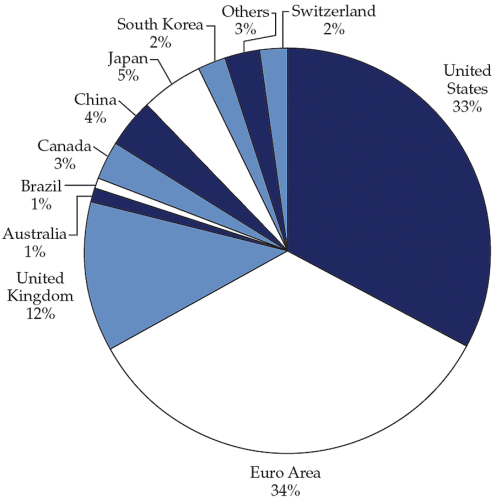Chinese Shadow Banking: Solution or Problem?
The Financial Stability Board (FSB) estimates that nonbank financial intermediary assets in China grew by more than 30% in 2013 (after taking into account changes in exchange rate). This phenomenal rate of growth has fueled concerns among many capital market participants about the risks of Chinese shadow banking. Is it sustainable? Will it eventually lead to another global financial crisis?
Before answering these questions, we need to understand the origin of Chinese shadow banking, its size relative to other jurisdictions, and the general sentiments of contemporary market participants.
Chinese Shadow Banking: The Origins
Chinese shadow banking growth originated from the relative lack of alternative funding channels for small and medium-sized enterprises (SMEs). Banking in China has always been a tightly controlled industry. Unlike its western counterparts — for whom the primary role of a bank is to enhance the flow of capital from entities with an excess of capital to those in need of it — the predominant guiding principle for Chinese banks is synchronization with national interests. And for the past two decades, national interest has consistently revolved around privatizing national enterprises, injecting them with ample capital, and facilitating these giants to take the lead in China’s investment-driven growth model.
As a result, the funding needs of SMEs are often sidelined. With conventional bank loans out of their reach, these private enterprises resorted to sourcing their funds from alternative finding channels. That created the capital demand side within the Chinese shadow-banking industry.
At the same time, there are strong regulatory restrictions in place to cap the interest rates of fixed deposits, capital protection funds, and other conventional wealth management products. And once we combine that with the heavy-handed, property-cooling measures by the Chinese government, Chinese investors are finding it tough to generate reasonable returns on their monetary assets. Enter the high-yielding (10% to 25% annual return) shadow-banking products.
China’s Shadow Banking Assets Remain Relatively Low
Despite the headline-grabbing double-digit annual growth rates, the amount of shadow banking assets in China have remained relatively low from a global perspective. In 2013, China only accounted for 4% of the universe of nonbank financial intermediation (a broad-based measure of shadow banking) monitored by the FSB.
Share of Assets of Nonbank Financial Intermediaries by Jurisdiction, 2013
Note: The euro area comprises five participating countries in the FSB survey: France, Italy, Germany, the Netherlands, and Spain.
Source: Based on data from FSB (2014)
This means that, of the estimated US$75.2 trillion of global nonbank financial intermediary assets, only approximately US$3 trillion originated in China. Relative to China’s status as the world’s second-largest economy by GDP (US$11.2 trillion in 2014), this amount is not significant. Indeed, both the United States and the European Union each accounted for approximately US$25 trillion of global shadow banking assets, which exceed the 2014 GDP (in current prices) for both jurisdictions.
Global Disconnect
Asia-Pacific Investors More Concerned about Chinese Shadow Banking Risks Than Counterparts in Other Regions
Based on the survey results featured in a recent CFA Institute publication on shadow banking, 56% of Asia-Pacific CFA Institute members who responded view the potential default of Chinese trust and wealth management products as posing the greatest systemic risk over the next two years. Only 25% of our global member respondents shared the same concerns (for American and EMEA members, it was 20% and 24%, respectively). It does seem that market participants who are closer to the Chinese shadow banking industry have a relatively more pessimistic read of the current situation.
Thus far, it seems that despite Chinese shadow banking’s relatively small asset base relative to its global counterparts, concern for the eventual buildup of systemic risk remains disproportionately high, especially among market participants who are closer to the source. In other words, it seems like a big problem. But once we take a step back, the problem might not lie within the shadow banking industry itself.
First, shadow bankers provided the much-needed credit to marginalized borrowers like small- and middle-scale property developers who were unable to obtain traditional financing from banks. Unlike conventional banks, shadow bankers can satisfy the short-term funding needs of these developers. This is the result of a vacuum in the SME banking sector, wherein the respective banking institutions have failed to address the specific needs of this group of potential clients.
Second, suppliers of capital within the shadow banking industry are typically individuals or corporations that are having difficulty getting a decent return on their money, for reasons that were explained previously. As a result, shadow bankers emerged to match the above-mentioned need for funding with the need for investing. Put another way, shadow banking is a solution and not a problem.
With that in mind, it might be more befitting to view shadow banking as a financial innovation, and propose ways to regulate it more effectively, rather than creating rules and regulations to render it illegal.
That would in principle translate to requiring all shadow bankers to be transparent about their business activities, as well as setting up a sinking fund-like structure among financial intermediaries to minimize the systemic damage from loan defaults.
Simultaneously, supporting more balanced capital market growth, where proper funding channels for different participants are made more readily available, would enhance the shadow banking system. Eventually, this would cushion the size of any eventual systemic risk, if any, within the shadow banking industry. If previously marginalized fund seekers have more options to consider, they would be discouraged from accepting harsher funding terms. That would slowly, but surely, eliminate unsustainable, high-yield products within the shadow banking industry that are very often the prime sources of contagion risk.
Of course, it is still up to the Chinese authorities to provide tangible incentives for stakeholders to seek more balanced growth within the conventional banking industry. After all, there is only so much policy reform can achieve without any actual support during implementation.
If you liked this post, consider subscribing to Market Integrity Insights.
Photo credit: iStockphoto.com/baphotte



WoW….
80% of Global S Banking (of 75 Trn.), controlled & managed by just 7 Nations – just d US & 6 European Countries (outta d 220 World Wide Nations)!
Amazing!!
Well, the distribution of shadowing banking markets also reflects the size of financial markets, where are the outliers? Japan is smaller than market size would suggest.
Thanks Zahir. I had the same feeling as you when I read the report for the first time. The facts are there, just requiring someone to dig them out and present them accordingly. I am very sure there are a lot more statistics out there waiting to get uncovered.